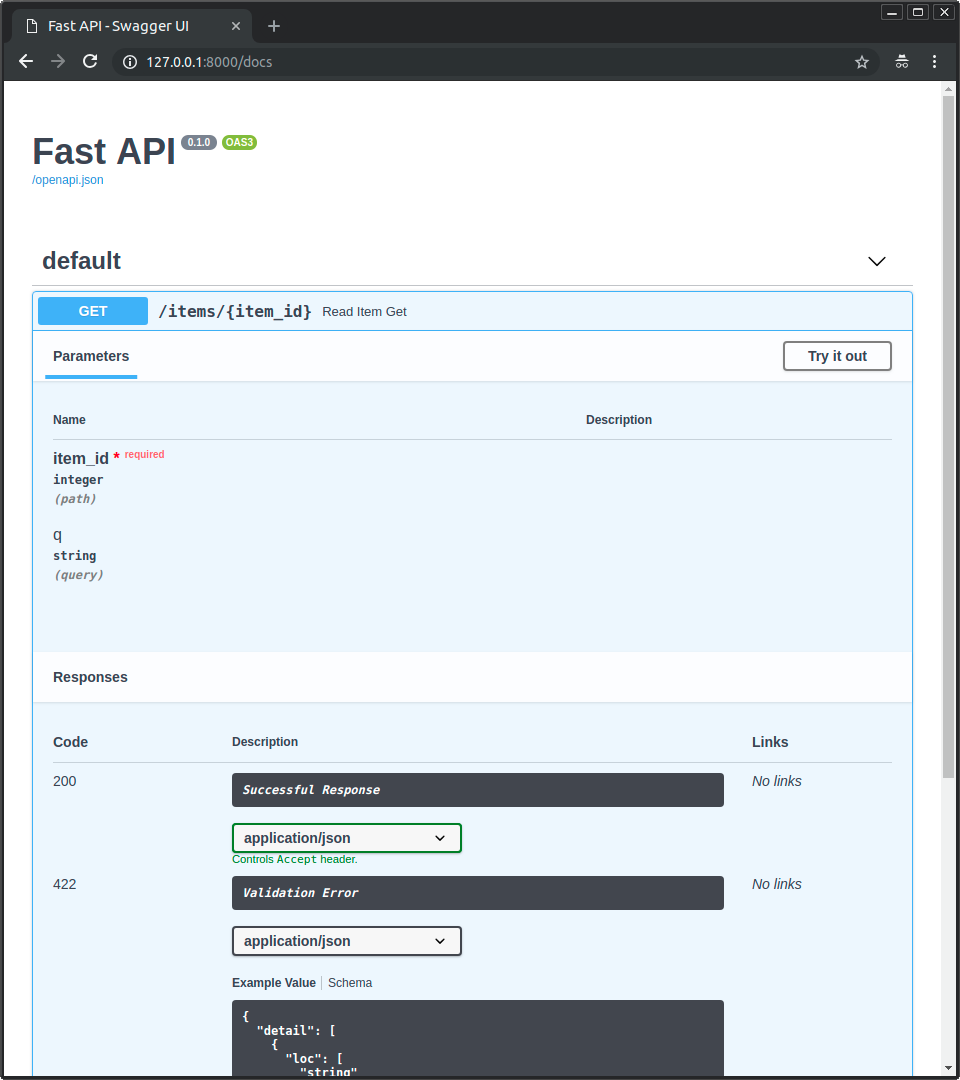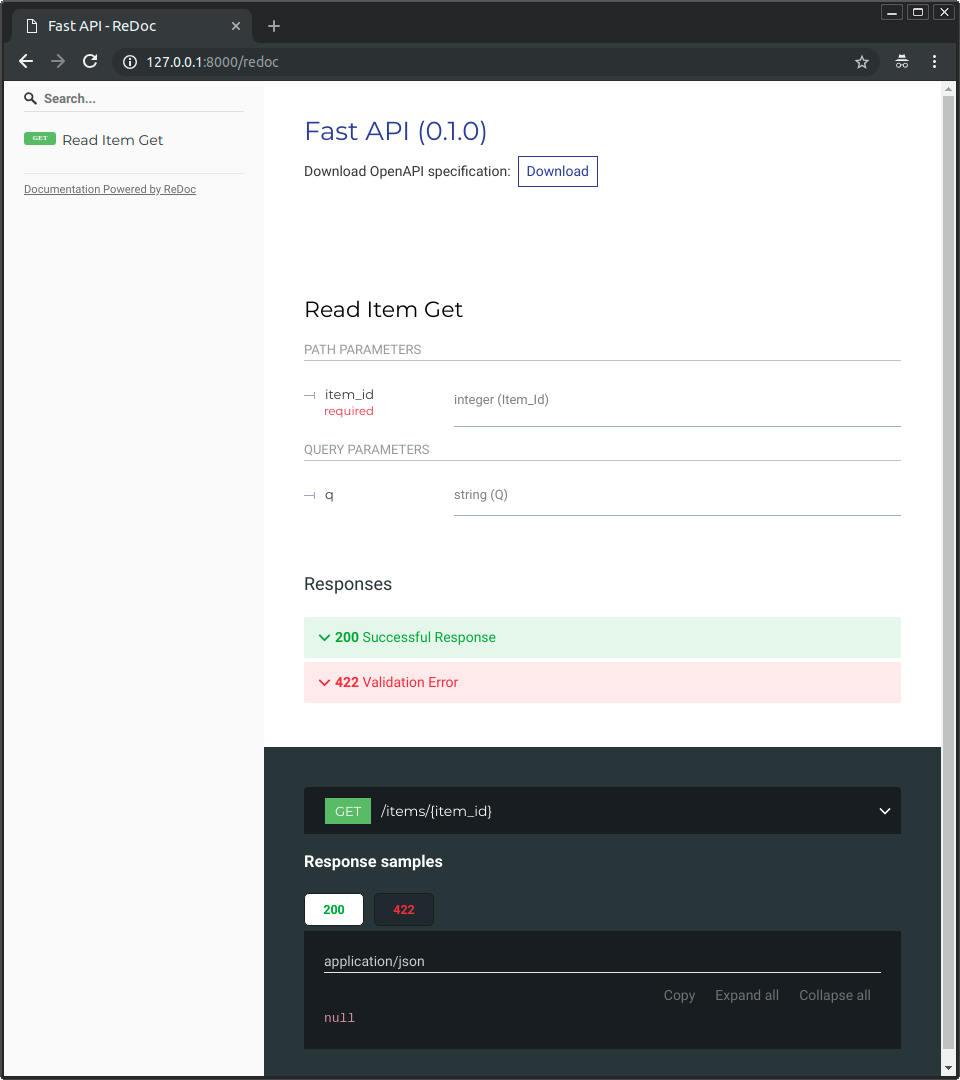--- /dev/null
+# 第一步
+
+最简单的 FastAPI 文件可能像下面这样:
+
+```Python
+{!../../../docs_src/first_steps/tutorial001.py!}
+```
+
+将其复制到 `main.py` 文件中。
+
+运行实时服务器:
+
+<div class="termy">
+
+```console
+$ uvicorn main:app --reload
+
+<span style="color: green;">INFO</span>: Uvicorn running on http://127.0.0.1:8000 (Press CTRL+C to quit)
+<span style="color: green;">INFO</span>: Started reloader process [28720]
+<span style="color: green;">INFO</span>: Started server process [28722]
+<span style="color: green;">INFO</span>: Waiting for application startup.
+<span style="color: green;">INFO</span>: Application startup complete.
+```
+
+</div>
+
+!!! note
+ `uvicorn main:app` 命令含义如下:
+
+ * `main`:`main.py` 文件(一个 Python「模块」)。
+ * `app`:在 `main.py` 文件中通过 `app = FastAPI()` 创建的对象。
+ * `--reload`:让服务器在更新代码后重新启动。仅在开发时使用该选项。
+
+
+在输出中,会有一行信息像下面这样:
+
+```hl_lines="4"
+INFO: Uvicorn running on http://127.0.0.1:8000 (Press CTRL+C to quit)
+```
+
+
+该行显示了你的应用在本机所提供服务的 URL 地址。
+
+### 查看
+
+打开浏览器访问 <a href="http://127.0.0.1:8000" class="external-link" target="_blank">http://127.0.0.1:8000</a>。
+
+你将看到如下的 JSON 响应:
+
+```JSON
+{"message": "Hello World"}
+```
+
+### 交互式 API 文档
+
+跳转到 <a href="http://127.0.0.1:8000/docs" class="external-link" target="_blank">http://127.0.0.1:8000/docs</a>。
+
+你将会看到自动生成的交互式 API 文档(由 <a href="https://github.com/swagger-api/swagger-ui" class="external-link" target="_blank">Swagger UI</a> 提供):
+
+
+
+### 可选的 API 文档
+
+前往 <a href="http://127.0.0.1:8000/redoc" class="external-link" target="_blank">http://127.0.0.1:8000/redoc</a>。
+
+你将会看到可选的自动生成文档 (由 <a href="https://github.com/Rebilly/ReDoc" class="external-link" target="_blank">ReDoc</a> 提供):
+
+
+
+### OpenAPI
+
+**FastAPI** 使用定义 API 的 **OpenAPI** 标准将你的所有 API 转换成「模式」。
+
+#### 「模式」
+
+「模式」是对事物的一种定义或描述。它并非具体的实现代码,而只是抽象的描述。
+
+#### API「模式」
+
+在这种场景下,OpenAPI 是一种规定如何定义 API 模式的规范。
+
+定义的 OpenAPI 模式将包括你的 API 路径,以及它们可能使用的参数等等。
+
+#### 数据「模式」
+
+「模式」这个术语也可能指的是某些数据比如 JSON 的结构。
+
+在这种情况下,它可以表示 JSON 的属性及其具有的数据类型,等等。
+
+#### OpenAPI 和 JSON Schema
+
+OpenAPI 为你的 API 定义 API 模式。该模式中包含了你的 API 发送和接收的数据的定义(或称为「模式」),这些定义通过 JSON 数据模式标准 **JSON Schema** 所生成。
+
+#### 查看 `openapi.json`
+
+如果你对原始的 OpenAPI 模式长什么样子感到好奇,其实它只是一个自动生成的包含了所有 API 描述的 JSON。
+
+你可以直接在:<a href="http://127.0.0.1:8000/openapi.json" class="external-link" target="_blank">http://127.0.0.1:8000/openapi.json</a> 看到它。
+
+它将显示以如下内容开头的 JSON:
+
+```JSON
+{
+ "openapi": "3.0.2",
+ "info": {
+ "title": "FastAPI",
+ "version": "0.1.0"
+ },
+ "paths": {
+ "/items/": {
+ "get": {
+ "responses": {
+ "200": {
+ "description": "Successful Response",
+ "content": {
+ "application/json": {
+
+
+
+...
+```
+
+#### OpenAPI 的用途
+
+驱动 FastAPI 内置的 2 个交互式文档系统的正是 OpenAPI 模式。
+
+并且还有数十种替代方案,它们全部都基于 OpenAPI。你可以轻松地将这些替代方案中的任何一种添加到使用 **FastAPI** 构建的应用程序中。
+
+你还可以使用它自动生成与你的 API 进行通信的客户端代码。例如 web 前端,移动端或物联网嵌入程序。
+
+## 分步概括
+
+### 步骤 1:导入 `FastAPI`
+
+```Python hl_lines="1"
+{!../../../docs_src/first_steps/tutorial001.py!}
+```
+
+`FastAPI` 是一个为你的 API 提供了所有功能的 Python 类。
+
+!!! note "技术细节"
+ `FastAPI` 是直接从 `Starlette` 继承的类。
+
+ 你可以通过 `FastAPI` 使用所有的 Starlette 的功能。
+
+### 步骤 2:创建一个 `FastAPI`「实例」
+
+```Python hl_lines="3"
+{!../../../docs_src/first_steps/tutorial001.py!}
+```
+
+这里的变量 `app` 会是 `FastAPI` 类的一个「实例」。
+
+这个实例将是创建你所有 API 的主要交互对象。
+
+这个 `app` 同样在如下命令中被 `uvicorn` 所引用:
+
+<div class="termy">
+
+```console
+$ uvicorn main:app --reload
+
+<span style="color: green;">INFO</span>: Uvicorn running on http://127.0.0.1:8000 (Press CTRL+C to quit)
+```
+
+</div>
+
+如果你像下面这样创建应用:
+
+```Python hl_lines="3"
+{!../../../docs_src/first_steps/tutorial002.py!}
+```
+
+将代码放入 `main.py` 文件中,然后你可以像下面这样运行 `uvicorn`:
+
+<div class="termy">
+
+```console
+$ uvicorn main:my_awesome_api --reload
+
+<span style="color: green;">INFO</span>: Uvicorn running on http://127.0.0.1:8000 (Press CTRL+C to quit)
+```
+
+</div>
+
+### 步骤 3:创建一个*路径操作*
+
+#### 路径
+
+这里的「路径」指的是 URL 中从第一个 `/` 起的后半部分。
+
+所以,在一个这样的 URL 中:
+
+```
+https://example.com/items/foo
+```
+
+...路径会是:
+
+```
+/items/foo
+```
+
+!!! info
+ 「路径」也通常被称为「端点」或「路由」。
+
+开发 API 时,「路径」是用来分离「关注点」和「资源」的主要手段。
+
+#### 操作
+
+这里的「操作」指的是一种 HTTP「方法」。
+
+下列之一:
+
+* `POST`
+* `GET`
+* `PUT`
+* `DELETE`
+
+...以及更少见的几种:
+
+* `OPTIONS`
+* `HEAD`
+* `PATCH`
+* `TRACE`
+
+在 HTTP 协议中,你可以使用以上的其中一种(或多种)「方法」与每个路径进行通信。
+
+---
+
+在开发 API 时,你通常使用特定的 HTTP 方法去执行特定的行为。
+
+通常使用:
+
+* `POST`:创建数据。
+* `GET`:读取数据。
+* `PUT`:更新数据。
+* `DELETE`:删除数据。
+
+因此,在 OpenAPI 中,每一个 HTTP 方法都被称为「操作」。
+
+我们也打算称呼它们为「操作」。
+
+#### 定义一个*路径操作装饰器*
+
+```Python hl_lines="6"
+{!../../../docs_src/first_steps/tutorial001.py!}
+```
+
+`@app.get("/")` 告诉 **FastAPI** 在它下方的函数负责处理如下访问请求:
+
+* 请求路径为 `/`
+* 使用 <abbr title="HTTP GET 方法"><code>get</code> 操作</abbr>
+
+!!! info "`@decorator` Info"
+ `@something` 语法在 Python 中被称为「装饰器」。
+
+ 像一顶漂亮的装饰帽一样,将它放在一个函数的上方(我猜测这个术语的命名就是这么来的)。
+
+ 装饰器接收位于其下方的函数并且用它完成一些工作。
+
+ 在我们的例子中,这个装饰器告诉 **FastAPI** 位于其下方的函数对应着**路径** `/` 加上 `get` **操作**。
+
+ 它是一个「**路径操作装饰器**」。
+
+你也可以使用其他的操作:
+
+* `@app.post()`
+* `@app.put()`
+* `@app.delete()`
+
+以及更少见的:
+
+* `@app.options()`
+* `@app.head()`
+* `@app.patch()`
+* `@app.trace()`
+
+!!! tip
+ 您可以随意使用任何一个操作(HTTP方法)。
+
+ **FastAPI** 没有强制要求操作有任何特定的含义。
+
+ 此处提供的信息仅作为指导,而不是要求。
+
+ 比如,当使用 GraphQL 时通常你所有的动作都通过 `post` 一种方法执行。
+
+### 步骤 4:定义**路径操作函数**
+
+这是我们的「**路径操作函数**」:
+
+* **路径**:是 `/`。
+* **操作**:是 `get`。
+* **函数**:是位于「装饰器」下方的函数(位于 `@app.get("/")` 下方)。
+
+```Python hl_lines="7"
+{!../../../docs_src/first_steps/tutorial001.py!}
+```
+
+这是一个 Python 函数。
+
+每当 **FastAPI** 接收一个使用 `GET` 方法访问 URL「`/`」的请求时这个函数会被调用。
+
+在这个例子中,它是一个 `async` 函数。
+
+---
+
+你也可以将其定义为常规函数而不使用 `async def`:
+
+```Python hl_lines="7"
+{!../../../docs_src/first_steps/tutorial003.py!}
+```
+
+!!! note
+ 如果你不知道两者的区别,请查阅 [Async: *"In a hurry?"*](https://fastapi.tiangolo.com/async/#in-a-hurry){.internal-link target=_blank}。
+
+### 步骤 5:返回内容
+
+```Python hl_lines="8"
+{!../../../docs_src/first_steps/tutorial001.py!}
+```
+
+你可以返回一个 `dict`、`list`,像 `str`、`int` 一样的单个值,等等。
+
+你还可以返回 Pydantic 模型(稍后你将了解更多)。
+
+还有许多其他将会自动转换为 JSON 的对象和模型(包括 ORM 对象等)。尝试下使用你最喜欢的一种,它很有可能已经被支持。
+
+## 总结
+
+* 导入 `FastAPI`。
+* 创建一个 `app` 实例。
+* 编写一个**路径操作装饰器**(如 `@app.get("/")`)。
+* 编写一个**路径操作函数**(如上面的 `def root(): ...`)。
+* 运行开发服务器(如 `uvicorn main:app --reload`)。